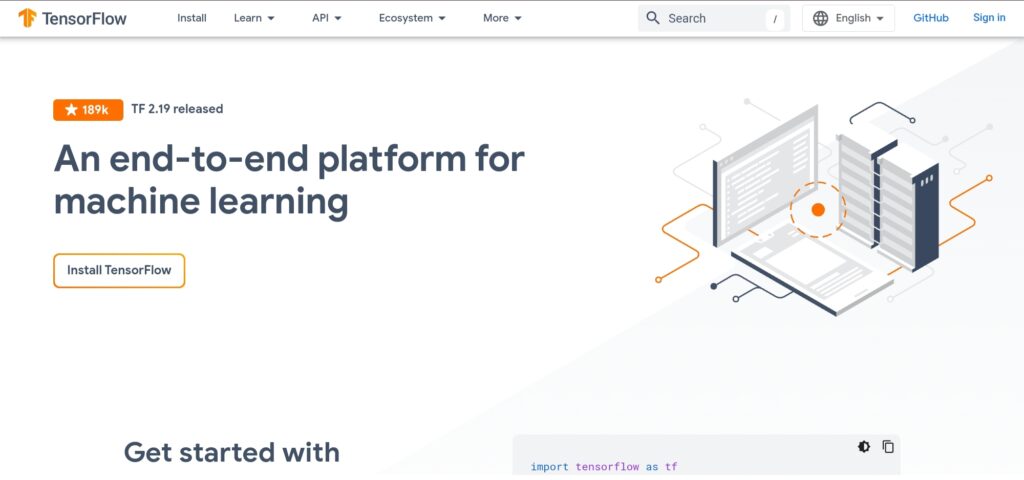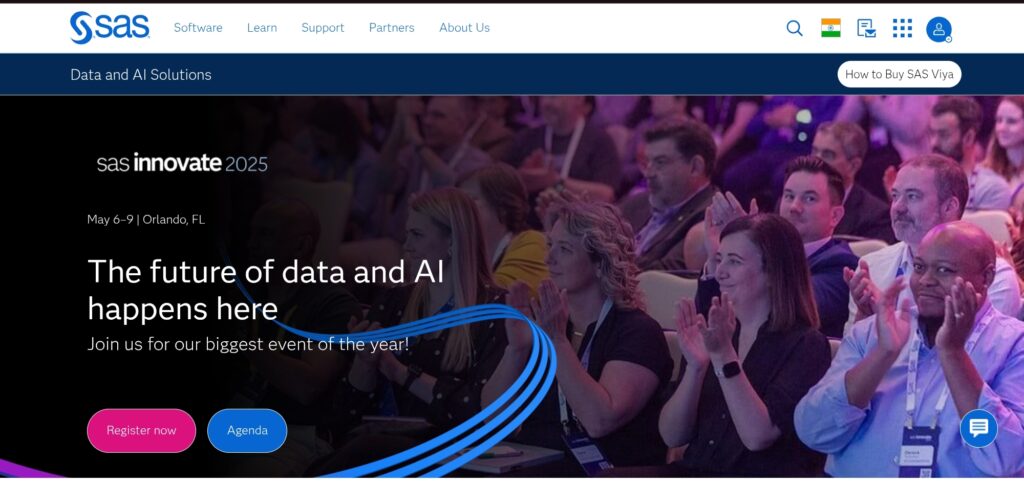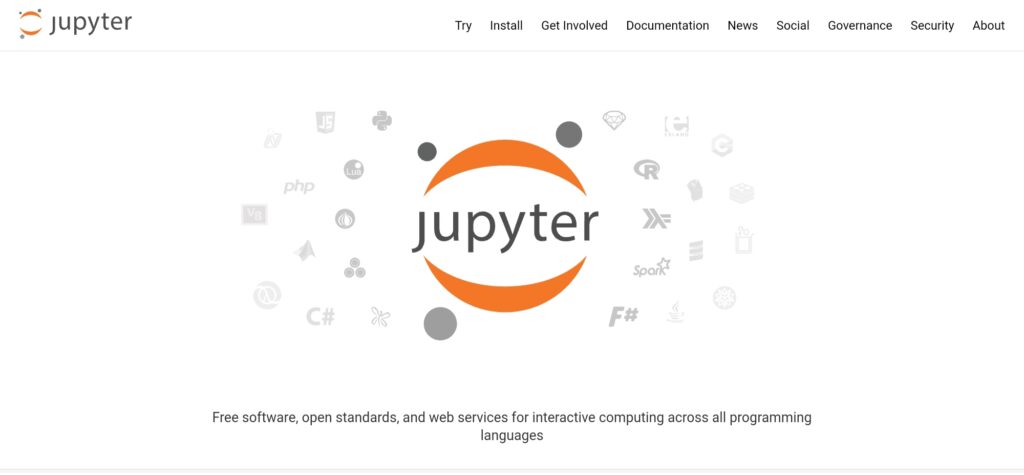Last updated on May 20th, 2025 at 06:53 pm
Data science is driving insights, transforming businesses, and enabling applications of Artificial Intelligence. Whether you are a skilled professional or an aspiring data scientist, having the appropriate toolkit is crucial.
Data processing, analysis, and interpretation are aided by the robust programming languages, analytical tools, and visualization platforms that make up the data science toolset. This post will describe the top 12 data science tools that any data scientist needs to be familiar with.
With the help of these tools, one can implement data science effectively even without coding and relative experience in this field. Data science professionals use a wide variety of tools to carry out different tasks in data science, and this list covers the top choices.
List of the Top Data Science Tools
1. Python: The Dynamic Programming Language
Python’s vast user base, ease of use, and intuitive syntax make it a great choice for data science. It is the most popular programming language among data scientists, and its extensive library and dynamic nature makes it the first choice over other languages.
There is a vast, growing, and active data science community for Python and is popularly used by top organizations like Google and IBM. Also, it is the language used to code more data science tools compared to other programming languages.
Python’s role in data science includes data preprocessing and analysis, machine learning model development, data visualization and automation.
The Pandas library of Python helps in data handling, cleaning and preparing data for analysis.
Machine learning libraries of Python like TensorFlow, PyTorch, and Scikit-learn help develop machine learning models for data classification, natural language processing, regression, and clustering.
Python’s ecosystem boasts a popular library called Matplotlib that excels in creating insightful visualizations. Data scientists can use this library to present their findings in an understandable way.
Where to learn Python?
You can learn Python programming language online with the following courses available on Udemy and Coursera.
Top Python Courses on Udemy
100 Days of Code: The Complete Python Pro Bootcamp
The Complete Python Bootcamp from Zero to Hero in Python
Automate the Boring Stuff with Python Programming
Top Python Courses on Coursera
Python for Everybody Specialization
Python for Data Science, AI & Development
2. R: The Language For Statistical Computing
R is a specialized programming language designed for various data science tasks such as statistical computing, data analysis, etc. Compared to Python, learning R is difficult and time-consuming.
However, learning Python will give you access to specialized packages designed to simplify complex statistical and data analysis problems. Also, it excels in big data handling with tools like Spark and Hadoop.
The specialized packages of R help in data manipulation, data visualization, statistical analysis and modelling.
Related: What Will You Learn In The Applied Data Science With R Specialization On Coursera?
Where to learn the R language?
The below courses on Coursera and Udemy will help you learn the R language.
Top R Courses on Udemy
R Programming A-Z: R For Data Science With Real Exercises
Data Science and Machine Learning Bootcamp with R
R Programming for Statistics and Data Science
Top R Courses on Coursera
Introduction to R Programming for Data Science
3. Tableau: Powerful Data Visualization Tool
Tableau is a versatile and powerful tool for data visualization that includes coherent features. It helps data scientists manage, visualize, and organize data from various sources in a single environment through charts, graphs, and dashboards.
Using Tableau is very easy due to its drag-and-drop interface that allows users to create insightful visualizations with no coding skills.
The primary uses of Tableau include data visualization, data integration, and real-time collaboration. Tableau can be integrated with different data sources like databases, spreadsheets, cloud services, big data platforms, and programming languages like R and Python to source data, and its data visualization functionalities can create insightful representations of this data quickly.
Where to learn Tableau?
Here are the highly rated online courses on Udemy and Coursera to learn Tableau.
Top Tableau Courses on Udemy
Tableau A-Z: Hands-On Tableau Training for Data Science
The Complete Tableau Analyst Bootcamp 2025
The Complete Introduction to Data Science with Tableau
Top Tableau Courses on Coursera
Data Visualization with Tableau Specialization
4. TensorFlow: Machine Learning Model Development
TensorFlow is an open-source library from Google that excels in the development and deployment of machine learning models effectively. It uses a data flow graph to portray mathematical operations as nodes and data as edges between these nodes.
TensorFlow offers an environment for developing, training, and deploying machine learning models. TensorFlow is a handy tool and is used in various fields like machine learning, deep learning, and artificial intelligence.
Where to learn TensorFlow?
The following courses on Udemy and Coursera will help you learn TensorFlow.
Top TensorFlow Courses on Udemy
Complete Guide to TensorFlow for Deep Learning with Python
TensorFlow for Deep Learning Bootcamp
Top TensorFlow Courses on Coursera
DeepLearning.AI TensorFlow Developer Professional Certificate
TensorFlow: Data and Deployment Specialization
5. Matplotlib: Popular Visualization Tool
Matplotlib is a popular Python library widely used for data visualization in data science. It creates charts, plots, and graphs to represent the findings of a data science life cycle.
It offers various customization facilities for data visualization, offering unmatched versatility and flexibility to users. Matplotlib helps identify trends, patterns, and relationships in data through its visualization facilities. Further, it helps in evaluating models and communicating results to stakeholders.
Where to Learn Matplotlib?
You can learn Matplotlib online by joining the following Udemy and Coursera Courses.
Top Matplotlib Courses on Udemy
Complete Course on Data Visualization, Matplotlib, and Python
Matplotlib Mastery: Python Data Visualization Unleashed
The Complete Matplotlib Course from Zero to Expert!
Top Matplotlib Courses on Coursera
Select Topics in Python: Matplotlib
6. Apache Spark: Big Data Framework
Apache Spark is an open-source big data processing framework designed by Apache Software Foundation. It has a combined analytics engine to analyze and work on large-scale data.
This data science tool performs several tasks like data cleaning, transformation, model building, and evaluation. The main feature of Apache Spark is the ability to work in memory. This quickens the data processing speed than traditional processing systems.
With multiple APIs, the Apache Spark framework makes it easy to access data repeatedly. Due to its distributed nature, data scientists use it to analyze large datasets and perform real-time data processing in applications like fraud detection and IoT data processing.
Spark has a graph processing library called GraphX that enables users to analyze and process graph data effectively.
Where to learn Apache Spark?
Here are the top courses on Udemy and Coursera to learn Apache Spark.
Top Apache Spark Courses on Udemy
PySpark: Apache Spark Programming in Python for Beginners
Learning Apache Spark; Master Spark for Big Data Processing
Top Apache Spark Courses on Coursera
Introduction to Big Data with Spark and Hadoop
Apache Spark with Scala – Hands-on with Big Data
7. Apache Hadoop: Distributed Storage Solution
Apache Hadoop is a distributed computing framework developed by the Apache Software Foundation. It is an open-source platform that can manage and store huge data files efficiently. Hadoop is suitable for high-level data processing and computations.
Parallel processing is an excellent feature offered by Hadoop that allows users to solve complex computational problems and data-intensive tasks and work with data clusters and nodes.
Hadoop facilitates batch data processing, allowing users to process huge data sets in batches and analyze historical data with ease. Also, this framework can store large volumes of data in a single location for future analysis. It stores log files from various sources so that data scientists can collect, store, and analyze them at once.
Hadoop offers several modules, such as Hadoop Common, Hadoop YARN, Hadoop MapReduce, Hadoop HDFS, etc.
Where to learn Hadoop?
You can join online courses on Udemy and Coursera to learn Apache Hadoop.
Top Apache Hadoop Courses on Udemy
Big Data and Hadoop for Absolute Beginners
The Ultimate Hands-on Hadoop: Tame your Big Data
Learn Big Data: The Hadoop Ecosystem Masterclass
Top Apache Hadoop Courses on Coursera
Introduction to Big Data with Spark and Hadoop
Hadoop Platform and Application Framework
8. Scikit-Learn: Machine Learning Library
Scikit-learn is another open-source Python library used for developing, training, and deploying machine learning models. It is a flexible, user-friendly, and widely popular framework used for data science and includes a set of tools for data analysis and machine learning.
Scikit-learn provides many machine learning algorithms for preprocessing, clustering, classification, regression, etc.
Where to learn Scikit-Learn?
The following Udemy and Coursera courses will teach you the concepts of Scikit-Learn.
Top Scikit-learn Courses on Udemy
Introduction to Machine Learning with Scikit-Learn
Master Machine Learning in Python with Scikit-Learn
Scikit-Learn in Python: 100+ Data Science Exercises
Top Scikit-learn Courses on Coursera
Introduction to Data Science and Scikit-Learn in Python
Scikit-Learn for Machine Learning Classification Problems
9. SAS
SAS, or Statistical Analysis System, is a statistical tool used for various data science tasks such as statistical analysis, data management, data visualization, and business intelligence.
Although it is less popular and has a smaller user base than Python or R, it is a useful tool for preprocessing, cleaning, and handling large datasets effectively. SAS can help perform quick and accurate data transformations and aggregations.
The use of SAS in data science includes efficient data handling, data mining, regression analysis, and time series analysis. Its excellent security features make it ideal for applications where sensitive data is involved.
10. Jupyter Notebook
As open-source software, Jupyter Notebook allows mutual collaboration among data scientists, data engineers, mathematicians, researchers, data analysts, and other individuals who use this platform.
Users can use Jupyter Notebook to create, edit, and share code, explanatory text, visualizations, equations, etc. It basically acts as a notebook where users can add information to a single document and share it with their colleagues for review.
This platform supports multiple programming languages, including Python, R, and Julia. Jupyter Notebook also includes JupyterLab, which is a web-based integrated development environment for code, data, and notebooks. This UI offers an integrated interface for data science, scientific computing, and machine learning.
Where to learn the Jupyter Notebook?
Learning Jupyter Notebook is easier with the online courses available on Udemy and Coursera.
Top Jupyter Notebook courses on Udemy
Practical Jupyter Notebook from Beginner to Expert
Jupyter Notebook for Data Science
Jupyter Notebook for Beginners
Top Jupyter Notebook Courses on Coursera
11. Power BI: Comprehensive Data Visualization Tool
Microsoft created the potent business intelligence (BI) application Power BI, which enables users to view data, produce insights, and make defensible decisions. Businesses, analysts, and data professionals frequently utilize it to turn unstructured data into dynamic dashboards and reports.
It connects to data sources like Excel, cloud services, web applications, and databases to source data for analysis. Performs data preprocessing with the Power Query editor. Due to its drag-and-drop facility, users can create interactive reports with ease.
In addition, built-in AI capabilities, real-time data analytics, and sharing options on the Power BI service and the mobile app make Power BI an outstanding data science tool. Its user-friendliness and scalability make it the perfect choice for large enterprises to small businesses.
Where to learn Power BI?
Udemy and Coursera offer multiple Power BI courses online where you can master this powerful business intelligence tool.
Top Power BI Courses on Udemy
Microsoft Power BI Desktop for Business Intelligence
Microsoft Power BI – Beginner to Pro
15 Days of Power BI – Complete Microsoft Power BI Bootcamp
Top Power BI Courses on Coursera
Microsoft Power BI Data Analyst Professional Certificate
Microsoft Power BI and Power Platform for Productivity Specialization
Data Analysis and Visualization with Power BI
12. D3.js
Data-Driven Documents, or D3.js, is a robust JavaScript toolkit that uses HTML, SVG, and CSS to create dynamic and interactive data visualizations in web browsers. It’s one of the most versatile and effective data visualization packages since it lets developers perform transformations and attach data to elements.
Because D3.js allows experts to produce informative, interactive visual representations of complicated datasets, it is extremely important in the field of data science.
Users can create personalized charts, graphs, and visual models with a great degree of flexibility and customization as compared to other data visualization tools. It efficiently handles massive datasets by combining DOM elements with large data sets.
Additionally, D3 interfaces with web technologies, offers intricate data visualizations, and is an excellent option for exploratory data analysis.
Where to learn D3.js?
If you want to learn D3.js, you can consider these online courses on Udemy and Coursera.
Top D3.js Courses on Udemy
Learn and Understand D3.js for Data Visualization
Mastering Data Visualization in D3.js
D3.js in Action: Build 17 D3.js Data Visualization Projects
Top D3.js Courses on Coursera
Final Thoughts
Gaining proficiency with these 12 data science tools—Python, R, Tableau, TensorFlow, Matplotlib, Apache Spark, Hadoop, Scikit-learn, SAS, Jupyter Notebook, Power BI, D3.js—enables data scientists to analyze patterns, draw conclusions, and make data-driven choices. You’ll be ready to take on challenging data problems and progress in your data science profession if you become proficient in these crucial technologies.
Share Now:
Related Articles
What is Data Science? A Beginner’s Guide to This Thriving Field
What is Data Science Foundations Specialization on Coursera?
Top Python Libraries For Data Science And Their Uses
A Day in the Life of a Data Scientist: What to Expect?
Discover more from coursekart.online
Subscribe to get the latest posts sent to your email.












